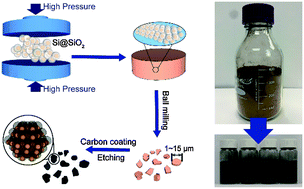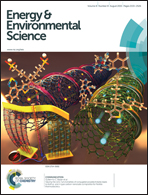A high tap density secondary silicon particle anode fabricated by scalable mechanical pressing for lithium-ion batteries†
Abstract
Much progress has been made in developing high capacity lithium ion battery electrode materials such as silicon anodes. With the powerful nanomaterial design approach, cycle life of silicon anodes has been increased significantly. However, nanomaterials have three major issues to be addressed, including severe side reactions due to a large surface area, low tap density and poor scalability. Nanostructured Si secondary clusters (nano-Si SC) are promising for reducing side reactions and increasing tap density, yet the scalability and tap density could still be further improved. Here, we propose a mechanical approach for SC fabrication to address all the problems. With the mechanical approach, >20 g of nano-Si SC per batch was produced even at our university lab scale, with >95% yield. Moreover, much denser packing of nanostructures can be achieved (1.38 g cm−3, pellet form), which gives much higher tap density (0.91 g cm−3, powder form) and better electrical contact. Accordingly, over 95% of initial capacity is retained after 1400 cycles at 1C, with an average specific capacity of ∼1250 mA h g−1. Stable cycling with >2 mg cm−2 of areal mass loading (∼3.5 mA h cm−2) is obtained. After uniformly integrating carbon nanotubes (CNTs) into SCs, intracluster electrical conductivity is further improved. As a result, notably enhanced rate capability is attained, with a high reversible specific capacity of ∼1140 mA h g−1 and ∼880 mA h g−1 at 2C and 4C, respectively.


 Please wait while we load your content...
Please wait while we load your content...